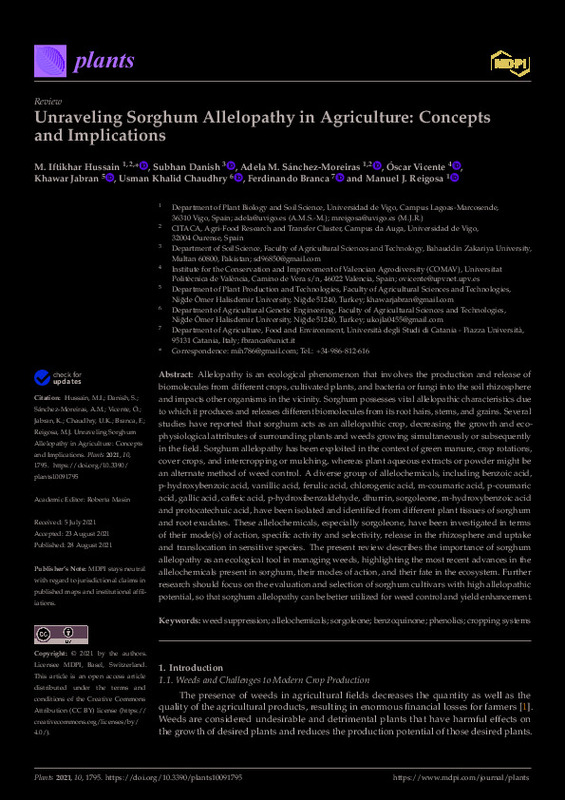JavaScript is disabled for your browser. Some features of this site may not work without it.
Buscar en RiuNet
Listar
Mi cuenta
Estadísticas
Ayuda RiuNet
Admin. UPV
Unraveling Sorghum Allelopathy in Agriculture: Concepts and Implications
Mostrar el registro sencillo del ítem
Ficheros en el ítem
| dc.contributor.author | Hussain, M. Iftikhar
|
es_ES |
| dc.contributor.author | Danish, Subhan
|
es_ES |
| dc.contributor.author | Sánchez-Moreiras, Adela M.
|
es_ES |
| dc.contributor.author | Vicente, Oscar
|
es_ES |
| dc.contributor.author | Jabran, Khawar
|
es_ES |
| dc.contributor.author | Chaudhry, Usman Khalid
|
es_ES |
| dc.contributor.author | Branca, Ferdinando
|
es_ES |
| dc.contributor.author | Reigosa, Manuel J.
|
es_ES |
| dc.date.accessioned | 2022-09-02T18:02:39Z | |
| dc.date.available | 2022-09-02T18:02:39Z | |
| dc.date.issued | 2021-09 | es_ES |
| dc.identifier.uri | http://hdl.handle.net/10251/185163 | |
| dc.description.abstract | [EN] Allelopathy is an ecological phenomenon that involves the production and release of biomolecules from different crops, cultivated plants, and bacteria or fungi into the soil rhizosphere and impacts other organisms in the vicinity. Sorghum possesses vital allelopathic characteristics due to which it produces and releases different biomolecules from its root hairs, stems, and grains. Several studies have reported that sorghum acts as an allelopathic crop, decreasing the growth and ecophysiological attributes of surrounding plants and weeds growing simultaneously or subsequently in the field. Sorghum allelopathy has been exploited in the context of green manure, crop rotations, cover crops, and intercropping or mulching, whereas plant aqueous extracts or powder might be an alternate method of weed control. A diverse group of allelochemicals, including benzoic acid, p-hydroxybenzoic acid, vanillic acid, ferulic acid, chlorogenic acid, m-coumaric acid, p-coumaric acid, gallic acid, caffeic acid, p-hydroxibenzaldehyde, dhurrin, sorgoleone, m-hydroxybenzoic acid and protocatechuic acid, have been isolated and identified from different plant tissues of sorghum and root exudates. These allelochemicals, especially sorgoleone, have been investigated in terms of their mode(s) of action, specific activity and selectivity, release in the rhizosphere and uptake and translocation in sensitive species. The present review describes the importance of sorghum allelopathy as an ecological tool in managing weeds, highlighting the most recent advances in the allelochemicals present in sorghum, their modes of action, and their fate in the ecosystem. Further research should focus on the evaluation and selection of sorghum cultivars with high allelopathic potential, so that sorghum allelopathy can be better utilized for weed control and yield enhancement | es_ES |
| dc.language | Inglés | es_ES |
| dc.publisher | MDPI | es_ES |
| dc.relation.ispartof | Plants | es_ES |
| dc.rights | Reconocimiento (by) | es_ES |
| dc.subject | Weed suppression | es_ES |
| dc.subject | Allelochemicals | es_ES |
| dc.subject | Sorgoleone | es_ES |
| dc.subject | Benzoquinone | es_ES |
| dc.subject | Phenolics | es_ES |
| dc.subject | Cropping systems | es_ES |
| dc.subject.classification | BIOQUIMICA Y BIOLOGIA MOLECULAR | es_ES |
| dc.title | Unraveling Sorghum Allelopathy in Agriculture: Concepts and Implications | es_ES |
| dc.type | Artículo | es_ES |
| dc.identifier.doi | 10.3390/plants10091795 | es_ES |
| dc.rights.accessRights | Abierto | es_ES |
| dc.contributor.affiliation | Universitat Politècnica de València. Departamento de Biotecnología - Departament de Biotecnologia | es_ES |
| dc.description.bibliographicCitation | Hussain, MI.; Danish, S.; Sánchez-Moreiras, AM.; Vicente, O.; Jabran, K.; Chaudhry, UK.; Branca, F.... (2021). Unraveling Sorghum Allelopathy in Agriculture: Concepts and Implications. Plants. 10(9):1-21. https://doi.org/10.3390/plants10091795 | es_ES |
| dc.description.accrualMethod | S | es_ES |
| dc.relation.publisherversion | https://doi.org/10.3390/plants10091795 | es_ES |
| dc.description.upvformatpinicio | 1 | es_ES |
| dc.description.upvformatpfin | 21 | es_ES |
| dc.type.version | info:eu-repo/semantics/publishedVersion | es_ES |
| dc.description.volume | 10 | es_ES |
| dc.description.issue | 9 | es_ES |
| dc.identifier.eissn | 2223-7747 | es_ES |
| dc.identifier.pmid | 34579328 | es_ES |
| dc.identifier.pmcid | PMC8470078 | es_ES |
| dc.relation.pasarela | S\444682 | es_ES |
| dc.subject.ods | 02.- Poner fin al hambre, conseguir la seguridad alimentaria y una mejor nutrición, y promover la agricultura sostenible | es_ES |
| dc.subject.ods | 13.- Tomar medidas urgentes para combatir el cambio climático y sus efectos | es_ES |








